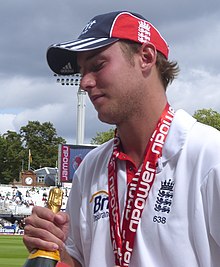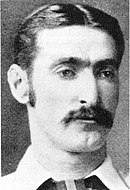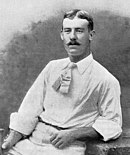List of Test cricket hat-tricks
 From Wikipedia - Reading time: 14 min
From Wikipedia - Reading time: 14 min

In cricket, a hat-trick occurs when a bowler takes a wicket with each of three consecutive deliveries. Although hat-tricks can carry over between innings, meaning a batter can be dismissed twice as part of the same hat-trick, they do not carry over between matches. As of December 2024, this feat has only been achieved 47 times, by 43 different bowlers, in more than two thousand men's Test matches,[1] the form of the sport in which national representative teams compete in matches of up to five days' duration.
The first Test hat-trick was recorded on 2 January 1879, in only the third Test match to take place, by the Australia pace bowler Fred Spofforth, nicknamed "The Demon Bowler",[2] who dismissed three England batters with consecutive deliveries at the Melbourne Cricket Ground. The most recent Test hat-trick was taken by Gus Atkinson in December 2024.
This article relates to men's cricket only. There have been three hat-tricks in women's Test cricket.
Notable Test hat-tricks
[edit]Bowlers with multiple Test hat-tricks
[edit]A player has taken two hat-tricks in the same Test match only once. Playing for Australia against South Africa in the first match of the 1912 Triangular Tournament at Old Trafford, Manchester, England, leg spinner Jimmy Matthews took a hat-trick in South Africa's first and second innings, both taken on 28 May 1912. He completed both hat-tricks by dismissing South Africa's Tommy Ward.[3] Only three other cricketers have taken more than one Test hat-trick: Australian off spinner Hugh Trumble (two years apart, between the same teams at the same ground), Pakistan fast bowler Wasim Akram (just over a week apart, in consecutive matches between the same teams) and England fast bowler Stuart Broad.
Test hat-tricks spread over two innings
[edit]Australian Merv Hughes is the only bowler to take a hat-trick where the wickets fell over three overs. This was at WACA, Perth in 1988. He took a wicket (Curtly Ambrose) with the final ball of an over. With the first ball of his next over he took the final wicket of the West Indies innings (Patrick Patterson). He then removed the opener Gordon Greenidge with the first ball of the West Indies second innings.[4] Even more unusually, Hughes's two first-innings wickets were not consecutive, since Tim May had bowled an over himself in between Hughes's two deliveries, and took the wicket of Gus Logie.[5]
Two other hat-tricks have taken place over two innings rather than one, both taken by West Indians against Australia – Courtney Walsh and Jermaine Lawson. Walsh's, at the Gabba in 1988, was unusual since, like Hughes' (which was in the very next Test in the series), other wickets fell between the beginning and end of the hat-trick. After dismissing Dodemaide to finish off Australia's first innings, Walsh did not open the bowling in the Australian second innings, and in fact did not bowl until Australia had already lost two wickets and were 65 for 2: then with his first two deliveries he dismissed Wood and Veletta. Lawson's hat trick was at the Kensington Oval in 2003. He removed tail-enders Lee and MacGill in successive deliveries before Australia declared their first innings (at 605/9), and then took the wicket of Langer with the first delivery of Australia's second innings.[6]
Other notable Test hat-tricks
[edit]- Three players have taken a hat-trick on their Test debut: English medium pace bowler Maurice Allom in 1930, New Zealand off-spinner Peter Petherick in 1976, and Australian pace bowler Damien Fleming in 1994.[7]
- Alok Kapali took the fewest total Test wickets of any player who recorded a hat-trick, taking only six wickets in his entire Test career.[7]
- Australian Peter Siddle is the only bowler to take a hat-trick on his birthday.[8]
- Bangladeshi off spinner Sohag Gazi is the only male player to score a century and take a hat-trick in the same Test match.[9]
- Sri Lankan seamer Nuwan Zoysa became the first player in the history to take a hat-trick off the first three balls of a Test match. He achieved this against Zimbabwe at Harare in November 1999, dismissing Trevor Gripper, Murray Goodwin and Neil Johnson.[10] Indian pacer Irfan Pathan is the second bowler to take a hat-trick in the first over of a Test match, against Pakistan in 2006.[11]
In the five-match series between a Rest of the World XI and England in 1970, a hat-trick was taken by South African Eddie Barlow in the fourth match, at Headingley (the last three of four wickets in five balls).[12] These matches were considered to be Tests at the time, but that status was later removed.[13]
Test hat-tricks
[edit]| Symbol | Meaning |
|---|---|
| Hat-trick taken in debut match | |
| Bowler | The name of the bowler |
| For | The team for which the bowler was playing |
| Against | The team against which the bowler was playing |
| Inn. | The innings (first or second) in which the hat-trick was achieved |
| Test | The number of the Test within the overall series between the two teams |
| Dismissals | The three players dismissed by the bowler |
| Venue | The venue where the hat-trick was achieved |
| Date | The date on which the hat-trick was achieved |
| Ref. | Reference |
By team
[edit]England and Australia combined have taken over half of all Test match hat-tricks to date, 26 of 47 (55.32%).[7]
| Team | Hat-tricks | No. of bowlers |
|---|---|---|
| 15 | 14 | |
| 11 | 9 | |
| 5 | 4 | |
| 4 | 4 | |
| 3 | 3 | |
| 2 | 2 | |
| 2 | 2 | |
| 2 | 2 | |
| 2 | 2 | |
| 1 | 1 | |
| Total | 47 | 43 |
By bowler
[edit]| Bowler | Hat-tricks |
|---|---|
| 2 | |
By ground
[edit]| Ground | Hat-tricks |
|---|---|
| 5 | |
| 3 | |
| 2 | |
See also
[edit]- List of One Day International cricket hat-tricks
- List of Twenty20 International cricket hat-tricks
- List of women's international cricket hat-tricks
References
[edit]- ^ McGhie, Tom (20 July 2011). "Landmark Test matches through the years as Lord's plays host to the 2,000th when England take on India". Daily Telegraph. Retrieved 3 January 2013.
- ^ "The Demon strikes three times". ESPNcricinfo. Retrieved 27 April 2018.
- ^ "Triangular Tournament − 1st match: Australia v South Africa Test Series – 1st Test". ESPNcricinfo. Retrieved 3 January 2012.
- ^ Lynch, Steven (13 October 2013). "Three-act plays". ESPNcricinfo. Retrieved 23 July 2015.
- ^ "Result". ESPN Cric Info. ESPNcricinfo. 6 December 1988. Retrieved 31 December 2022.
- ^ "Aussies complete victory to take 3-0 series lead". landofsixpeoples.com. Retrieved 1 June 2024.
- ^ a b c "Record / Test matches / Bowling record / Hat-tricks". ESPNcricinfo. Retrieved 3 January 2012.
- ^ McGlashan, Andrew (25 November 2010). "Siddle hat-trick gives Australia control". ESPNcricinfo. Retrieved 13 October 2013.
- ^ Islam, Mohammad (13 October 2013). "Gazi shines as Test ends in draw". ESPNcricinfo. Retrieved 13 October 2013.
- ^ "Zimbabwe v Sri Lanka 1999-2000". ESPNcricinfo. Retrieved 22 April 2023.
- ^ "Pakistan vs India 3rd Test 2006". ESPNcricinfo. Retrieved 6 January 2020.
- ^ "England v Rest Of The World, 1970 – 4th match". ESPNcricinfo. 29 September 2005. Retrieved 3 January 2012.
- ^ "July 2000 – The best of the best?". ESPNcricinfo. Retrieved 3 January 2012.
- ^ "England tour of Australia, 1878/79 – Only Test". ESPNcricinfo. Retrieved 4 January 2013.
- ^ "England (IFW Bligh's XI) tour of Australia, 1882/83: The Ashes – 2nd Test". ESPNcricinfo. Retrieved 4 January 2013.
- ^ "England (Lord Sheffield's XI) tour of Australia, 1891/92: The Ashes – 2nd Test". ESPNcricinfo. Retrieved 4 January 2013.
- ^ "England tour of South Africa, 1895/96 – 1st Test". ESPNcricinfo. Retrieved 4 January 2013.
- ^ "Australia tour of England, 1899: The Ashes – 3rd Test". ESPNcricinfo. Retrieved 4 January 2013.
- ^ "England tour of Australia, 1901/02: The Ashes – 2nd Test". ESPNcricinfo. Retrieved 4 January 2013.
- ^ "England (Marylebone Cricket Club) tour of Australia, 1903/04: The Ashes – 5th Test". ESPNcricinfo. Retrieved 4 January 2013.
- ^ a b "Triangular Tournament, 1912: Australia v South Africa Test Series −1st Test". ESPNcricinfo. Retrieved 4 January 2013.
- ^ "England tour of New Zealand, 1929/30 – 1st Test". ESPNcricinfo. Retrieved 4 January 2013.
- ^ "England tour of South Africa, 1938/39 – 1st Test". ESPNcricinfo. Retrieved 4 January 2013.
- ^ "West Indies tour of England, 1957 – 4th Test". ESPNcricinfo. Retrieved 4 January 2013.
- ^ "Australia tour of South Africa, 1957/58 – 2nd Test". ESPNcricinfo. Retrieved 4 January 2013.
- ^ "Full Scorecard of West Indies vs Pakistan 3rd Test 1958/59 - Score Report | ESPNcricinfo.com". ESPNcricinfo. Retrieved 4 July 2021.
- ^ "South Africa tour of England, 1960 – 2nd Test". ESPNcricinfo. Retrieved 4 January 2013.
- ^ "West Indies tour of Australia, 1960/61 – 4th Test". ESPNcricinfo. Retrieved 4 January 2013.
- ^ "New Zealand tour of Pakistan, 1976/77 – 1st Test". ESPNcricinfo. Retrieved 4 January 2013.
- ^ "West Indies tour of Australia, 1988/89: The Frank Worrell Trophy – 1st Test". ESPNcricinfo. Retrieved 4 January 2013.
- ^ "West Indies tour of Australia, 1988/89: The Frank Worrell Trophy – 2nd Test". ESPNcricinfo. Retrieved 4 January 2013.
- ^ "Australia tour of Pakistan, 1994/95 – 2nd Test". ESPNcricinfo. Retrieved 4 January 2013.
- ^ "England tour of Australia, 1994/95: The Ashes – 2nd Test". ESPNcricinfo. Retrieved 4 January 2013.
- ^ "West Indies tour of England, 1995: The Wisden Trophy – 4th Test". ESPNcricinfo. Retrieved 4 January 2013.
- ^ "England tour of Australia, 1998/99: The Ashes – 5th Test". ESPNcricinfo. Retrieved 4 January 2013.
- ^ "Asian Championship Test, 1998/99 – 3rd Test". ESPNcricinfo. Retrieved 4 January 2013.
- ^ "Asian Championship Test, 1998/99 – Final". ESPNcricinfo. Retrieved 4 January 2013.
- ^ "Sri Lanka tour of Zimbabwe, 1999/00 – 2nd Test". ESPNcricinfo. Retrieved 4 January 2013.
- ^ "Pakistan tour of Sri Lanka, 2000 – 2nd Test". ESPNcricinfo. Retrieved 4 January 2013.
- ^ "West Indies tour of Australia, 2000/01 – 2nd Test". ESPNcricinfo. Retrieved 4 January 2013.
- ^ "Australia tour of India, 2000/01 – 2nd Test". ESPNcricinfo. Retrieved 4 January 2013.
- ^ "Asian Championship Test, 2001/02 – Final". ESPNcricinfo. Retrieved 4 January 2013.
- ^ "Australia tour of West Indies, 2003: The Frank Worrell Trophy – 3rd Test". ESPNcricinfo. Retrieved 4 January 2013.
- ^ "Bangladesh tour of Pakistan, 2003 – 2nd Test". ESPNcricinfo. Retrieved 4 January 2013.
- ^ "Bangladesh tour of Zimbabwe, 2003/04 – 1st Test". ESPNcricinfo. Retrieved 4 January 2013.
- ^ "England tour of West Indies, 2003/04: The Wisden Trophy – 3rd Test". ESPNcricinfo. Retrieved 4 January 2013.
- ^ "New Zealand tour of Bangladesh, 2004/05 – 1st Test". ESPNcricinfo. Retrieved 4 January 2013.
- ^ "India tour of Pakistan, 2005/06 – 3rd Test". ESPNcricinfo. Retrieved 4 January 2013.
- ^ "England tour of New Zealand, 2007/08 – 1st Test". ESPNcricinfo. Retrieved 4 January 2013.
- ^ "England tour of Australia, 2010/11: The Ashes – 1st Test". ESPNcricinfo. Retrieved 4 January 2013.
- ^ "India tour of England, 2011: Pataudi Trophy – 2nd Test". ESPNcricinfo. Retrieved 4 January 2013.
- ^ "New Zealand tour of Bangladesh, 1st Test". ESPNcricinfo. Retrieved 13 October 2013.
- ^ "Sri Lanka tour of England, 2nd Test". ESPNcricinfo. Retrieved 20 June 2014.
- ^ "Australia tour of Sri Lanka, 2nd Test". ESPNcricinfo. Retrieved 5 August 2016.
- ^ "Full Scorecard of England vs South Africa 3rd Test 2017 - Score Report | ESPNcricinfo.com". ESPNcricinfo. Retrieved 4 July 2021.
- ^ "Full Scorecard of India vs West Indies 2nd Test 2019-2021 - Score Report | ESPNcricinfo.com". ESPNcricinfo. Retrieved 4 July 2021.
- ^ "1st Test, ICC World Test Championship at Rawalpindi, Feb 7-11 2020". ESPNcricinfo. Retrieved 9 February 2020.
- ^ "2nd Test, Gros Islet, Jun 18 - 22 2021, South Africa tour of West Indies". ESPNcricinfo. Retrieved 21 June 2021.
- ^ "NZ vs ENG Cricket Scorecard, 2nd Test at Wellington, December 06 - 10, 2024". ESPNcricinfo. Retrieved 6 December 2024.
 KSF
KSF




